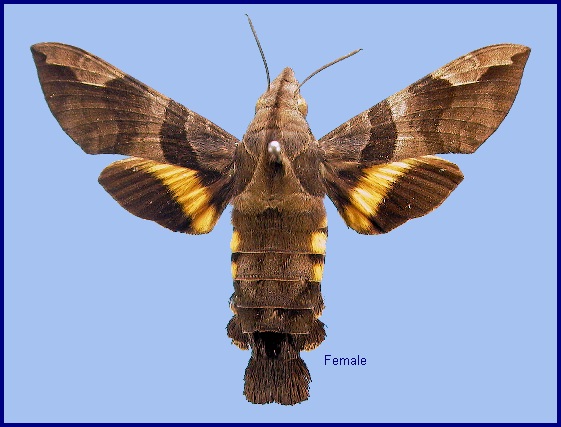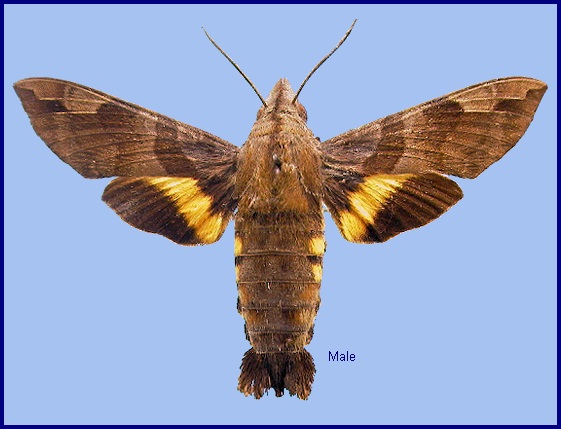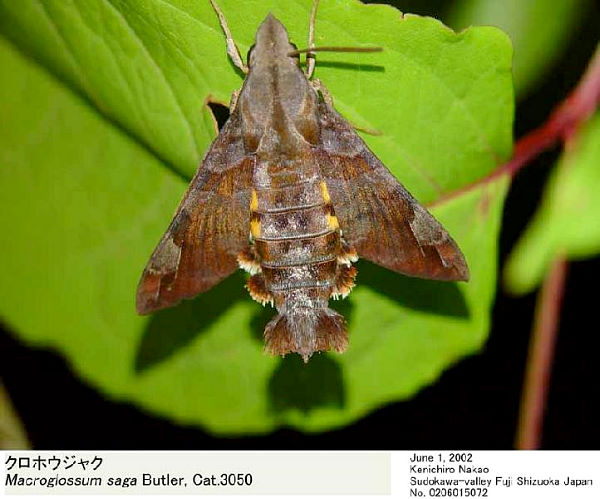

Macroglossa saga Butler, 1878, Entomologist's mon. Mag. 14: 206. Type locality: Japan: [Honshu, Kanagawa,] <<Yokohama>>.
Synonym. Macroglossa kiushiuensis Rothschild, 1894.
Synonym. Macroglossa glaucoplaga Hampson, 1900.
[Further details on this species in Japan, as well as photos of many stages, can be found on Digital Moths of Japan as well as Moths of the southern Shikoku, Japan.]
Wingspan: 54--66mm. Forewing upperside with pale and dark areas well contrasted; antemedian lines curved, filled in with brownish black to form a band that is dilated basad at the hind margin; median area grey; first and second discal lines angled at vein M1, concave between M1 and hind margin, the space between dark except posteriorly; first line not usually prominent posteriorly; grey costal area extended to apex of wing, the subapical rufous patch between veins Rs3 and Rs4 shaded with grey; the grey postdiscal line here conspicuous, and vein M1 grey between the second and third discal lines; the grey area limited by the apical chevron, by the subapical patch behind vein Rs4, and by the grey line of vein M1; the area behind the grey patch blackish. Both wings undersides dark russet, somewhat shaded with grey on hindwing. Hindwing upperside yellow band of variable width, barely half the width of the black border at vein M2; fringe reddish cinnamon. Hindwing underside yellow anal area not sharply defined distally.
Head and thorax upperside with darker mesial streak; no white line above eye. Abdomen upperside with two yellow lateral patches, with a further vestigial patch on second segment; a double series of dark dorsal spots; tail blackish-brown dorsally; side tufts of posterior segments with dark buff tips, those of the proximal segments white tipped. Palpi long, white speckled with black scales ventrally. Thorax underside greyish wood-brown. Abdomen underside uniform in colour.
In the male genitalia, uncus somewhat prism-shaped, truncate apically. Gnathos rounded apically. Valve with stridulatory scales. Harpe very short, obtusely pointed, conical. Phallus with process variably dentate only basally, slightly extending onto the phallus itself; internal rods obtuse apically.



A species of woodland meadows and open areas of burnt and logged woodland in the Russian Far East, where it generally flies in the afternoon (Izerskiy, 1999b). However, it is also known to fly at night (Spitsyna & Spitsyn, 2023).
Macroglossum saga is now a common species on Kunashir Island, with up to 15 specimens being observed feeding from flowers during one evening in good weather (Spitsyna & Spitsyn, 2023).

China: i-iii (Hong Kong); 12.vi (Yunnan); 15.vi (Zhejiang); vii (Sichuan; Yunnan); ix (Zhejiang); x (Hong Kong). Taiwan: 19.ii (Taoyuan Hsien); 21.vi (Nantou Hsien); Japan: v (Ryukyu Archipelago); 27.v-28.vii (Hokkaido); vi-vii (Honshu; Kyushu; Ryukyu Archipelago); 28.viii (Hokkaido); ix-x (Kyushu; Honshu); 28.ix-7.x (Hokkaido); 30.x (Shikoku). Russia: 23.viii (Primorskiy Krai); 1-20.ix (Kunashir Island, Kurile Islands).
Park et al. (1999) give late June until late October as the flight period in Korea.
OVUM: Although Mell (1922) bred this species, no details were recorded.
LARVA: Full-fed 43--46mm. Although Mell (1922) bred this species, no details were recorded.; however, see Moths of the southern Shikoku, Japan
PUPA: Although Mell (1922) bred this species, no details were recorded.
Larval hostplants. Recorded in Japan and Korea on Daphniphyllum macropodum (Daphniphyllaceae) (Nagano, 1904; Park et al., 1999; Kaneko, 2005).
On Taiwan recorded from Daphniphyllum glaucescens, Daphniphyllum macropodum and Aidia cochinchinensis [syn. Randia cochinchinensis].
China: ?Nei Mongol (Urad Qianqi); Beijing (Baihua Shan); Sichuan (Emei Shan); Yunnan (nr. Yingjiang, 2080m; Gaoligong Shan; Kunming; Dali); south Xizang/Tibet (Mutu, Namjagbarwa region, 1600m (Wang, 1988)); Zhejiang (Beiji Island; Dalong); Hunan (Xiaozhuangping); Guangdong; Hong Kong (Tai Lung; Ho Piu).
Taiwan: Nantou Hsien (Tienchi, 1860m; Tatachia); Taipei Hsien (Fushan); Kaohsiung Hsien (Shanping, 640m); Taoyuan Hsien (Taoyuan City).
South Korea: Seoul; Kyonggi Province (Asan Bay); Kangwon Province (Gubong-san); South Cholla Province (Baekyang Temple; Mudeung-san; Hong-do; Gwangyang); South Kyongsang (Jinju; Geoje-do; Goseong; Namhae; Sancheong; Jinyang; Hadong; Hamyang; Hapcheon); Cheju Province (Cheju-do; Halla-san; Youngsil; Sungpanak; Sinsan; Topyung; Ara-dong; Ora-dong; Cheonjiyun; Donnaeko; Gyolae-ri; Isidol; Ipseok-dong; Suakbong).
Japan: Hokkaido; Honshu (Karuizawa; Norikura Kogen, 1500m; Sejogahara; Kiyosato, 1300m; Tokyo; Dorokawa; Kyoto; Kobe; Fujiwara, Gunma Pref.; Oki Islands); Shikoku (Matsuyama; Usa); Kyushu (Hikosan); Hachijo-jima; Ryukyu Archipelago (Okinawa; Awa-jima; Yaku-jima; Ishigaki-jima (Entani, 2011)).
Russia: Primorskiy Krai (Primorskiy; Kedrovaya Pad Nature Reserve); Kurile Islands (Kunashir Island).
Northern India (Mussoorie, Uttarakhand (Bhuyan, Clark & Smetacek, 2019)), Nepal, Sikkim, Bhutan (Norbu et al., 2022), northeastern India (Arunachal Pradesh, Nagaland), southern China, northern Vietnam (Sa Pa), Taiwan, South Korea, Japan, and northern and western Thailand. A recent 'colonist' of the Russian Far East and the Kurile Islands; it is not known if it is a late summer vagrant or if it is now resident in this area.

 Return to Sphingidae of the Eastern Palaearctic species list
Return to Sphingidae of the Eastern Palaearctic species list